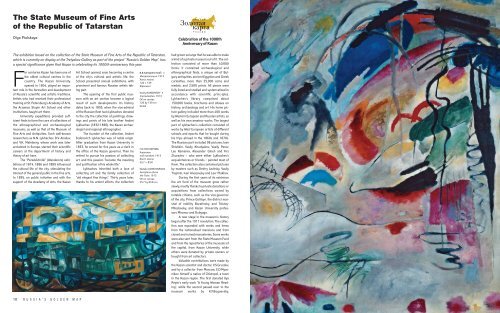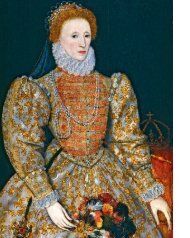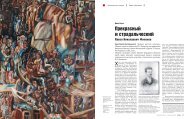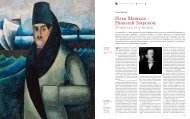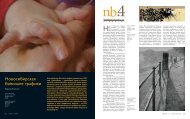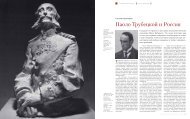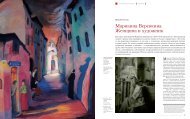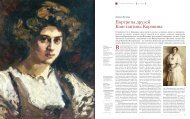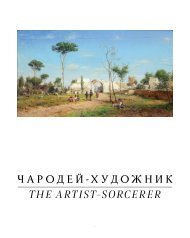ÐÑзей изобÑазиÑелÑнÑÑ Ð¸ÑкÑÑÑÑв РеÑпÑблики ТаÑаÑÑÑан
ÐÑзей изобÑазиÑелÑнÑÑ Ð¸ÑкÑÑÑÑв РеÑпÑблики ТаÑаÑÑÑан
ÐÑзей изобÑазиÑелÑнÑÑ Ð¸ÑкÑÑÑÑв РеÑпÑблики ТаÑаÑÑÑан
Create successful ePaper yourself
Turn your PDF publications into a flip-book with our unique Google optimized e-Paper software.
The State Museum of Fine Arts<br />
of the Republic of Tatarstan<br />
Olga Piulskaya<br />
Celebration of the 1000th<br />
Anniversary of Kazan<br />
The exhibition based on the collection of the State Museum of Fine Arts of the Republic of Tatarstan,<br />
which is currently on display at the Tretyakov Gallery as part of the project “Russia's Golden Map”, has<br />
a special significance given that Kazan is celebrating its 1000th anniversary this year.<br />
For centuries Kazan has been one of<br />
the oldest cultural centres in the<br />
country. The Kazan University,<br />
opened in 1804, played an important<br />
role in the formation and development<br />
of Russia's scientific and artistic traditions.<br />
Artists who had received their professional<br />
training at St. Petersburg's Academy of Arts,<br />
the Arzamas Stupin Art School and other<br />
institutions, taught art there.<br />
University expeditions provided sufficient<br />
finds to form the core of collections of<br />
the ethnographical and archaeological<br />
museums, as well as that of the Museum of<br />
Fine Arts and Antiquities. Such well-known<br />
researchers as N.N. Lykhachev, D.V. Ainalov,<br />
and V.K. Malmberg, whose work was later<br />
acclaimed in Europe, started their scientific<br />
careers at the department of history and<br />
theory of art here.<br />
The “Peredvizhniki” (Wanderers) exhibitions<br />
of 1874, 1886 and 1889 influenced<br />
the cultural life of the city, stimulating the<br />
interest of the general public in the fine arts.<br />
In 1895, on public initiative and with the<br />
support of the Academy of Arts, the Kazan<br />
Art School opened, soon becoming a centre<br />
of the city's cultural and artistic life; the<br />
School presented annual exhibitions, with<br />
prominent and famous Russian artists taking<br />
part.<br />
The opening of the first public museum<br />
with an art section became a logical<br />
result of such developments. Its history<br />
dates back to 1895, when the vice-admiral<br />
of the Russian fleet Ivan Lykhachev donated<br />
to the city the collection of paintings, drawings<br />
and prints of his late brother Andrei<br />
Lykhachev (1832-1890), the Kazan archaeologist<br />
and regional ethnographer.<br />
The founder of the collection, Andrei<br />
Fedorovich Lykhachev was of noble origin.<br />
After graduation from Kazan University in<br />
1853, he served for five years as a clerk in<br />
the office of the Kazan governor. Then he<br />
retired to pursue his passion of collecting<br />
art, and this passion “became the meaning<br />
and justification of his whole life.”<br />
Lykhachev inherited both a love of<br />
collecting art and the family collection of<br />
“old elegant fine things”. Thirty years later,<br />
thanks to his ardent efforts, the collection<br />
В.В.КАНДИНСКИЙ <br />
Импровизация. 1913<br />
Холст, масло<br />
120 × 139<br />
Фрагмент<br />
Vasily KANDINSKY <br />
Improvisation. 1913<br />
Oil on canvas<br />
120 by 139 cm<br />
Detail<br />
Н.С.ГОНЧАРОВА<br />
Аэроплан<br />
над поездом. 1913<br />
Холст, масло<br />
55,7 × 83,8<br />
Natalia GONCHAROVA<br />
Aeroplane above<br />
the Train. 1913<br />
Oil on canvas<br />
55.7 by 83.8 cm<br />
had grown so large that he was able to make<br />
a kind of a private museum out of it. The collection<br />
consisted of more than 40,000<br />
items: it contained archaeological and<br />
ethnographical finds, a unique set of Bulgary<br />
antiquities, ancient Egyptian and Greek<br />
curiosities, more than 25,000 coins and<br />
medals, and 2,500 prints. All pieces were<br />
fully listed and studied and system-atised in<br />
accordance with scientific princ-iples.<br />
Lykhachev's library comprised about<br />
150,000 books, brochures and atlases on<br />
history, archaeology and art. His home picture<br />
gallery included more than 400 works<br />
by Western European and Russian artists, as<br />
well as his own amateur works. The largest<br />
part of Lykhachev's collection consisted of<br />
works by West European artists of different<br />
schools and epochs that he bought during<br />
his trips abroad in the 1860s and 1870s.<br />
The Russian part included 98 pictures; Ivan<br />
Shishkin, Vasily Khudyakov, Vasily Perov,<br />
Leo Kamenev, Alexander Gineh and Firs<br />
Zhuravlev – who were either Lykhachev's<br />
acquaintances or friends – painted most of<br />
them. The collection also contained pictures<br />
by masters such as Dmitry Levitsky, Vasily<br />
Tropinin, Ivan Aivazovsky and Lavr Plakhov.<br />
During the first years of its existence<br />
the art fund of the museum grew rather<br />
slowly, mostly thanks to private donations or<br />
acquisitions from collections owned by<br />
notable citizens, such as the vice-governor<br />
of the city, Prince Golitsyn, the district marshal<br />
of nobility Boratinsky, and Tolstoy-<br />
Miloslavsky, and Kazan University professors<br />
Mironov and Dubyago.<br />
A new stage in the museum's history<br />
began after the 1917 revolution. The collection<br />
was expanded with works and items<br />
from the nationalised mansions and from<br />
closed and ruined monasteries. Some works<br />
were also sent from the State Museum Fund<br />
and from the repositories of the museums of<br />
the capital, from Kazan University, while<br />
others were donated by private owners or<br />
bought from art collectors.<br />
Valuable contributions were made by<br />
the Kazan scientist and doctor, V.S.Gruzdev,<br />
and by a collector from Moscow, E.D.Myasnikov,<br />
himself a native of Chistopol, a town<br />
in the Kazan region. The first donated Ilya<br />
Repin's early work “A Young Woman Reading”,<br />
while the second passed over to the<br />
museum works by K.F.Bogaevsky,<br />
10 R U S S I A ’ S G O L D E N M A P<br />
ЗОЛОТАЯ КАРТА РОССИИ RUSSIA’S GOLDEN MAP 11


